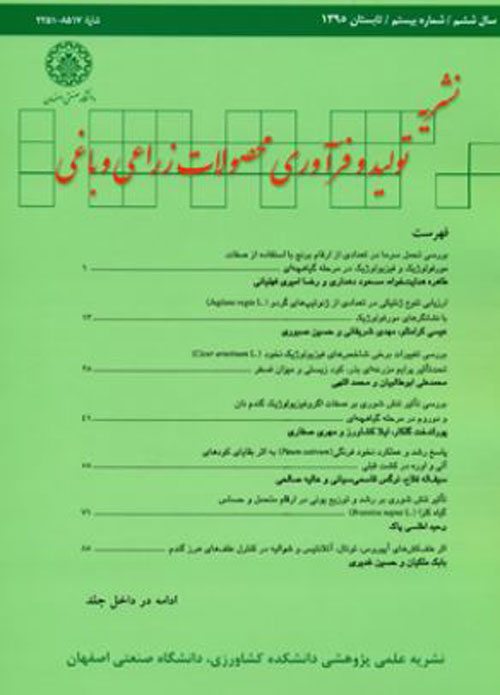Evaluation of ion distribution in different tissues of wheat (Triticum aestivum L.) cultivars differing in salt tolerance
Author(s):
Abstract:
An understanding of physiological mechanisms of salt tolerance is necessary for breeding programs, in order to select the desired trait in different wheat genotypes. Three bread wheat genotype differing in salt tolerance were employed to assess ion distribution and growth responses under saline conditions. To evaluate ion distribution in plant, sodium and potassium concentrations as well as Kﳖ ratios in different tissues including root, leaf 3 blade, flag leaf sheath and flag leaf blade were assessed in a pot experiment in the glasshouse using a factorial experiment based on a randomized complete block design with three replications . Four levels of NaCl (0, 50, 100 and 150 mM NaCl) were imposed as the salinity treatments when the leaf 4 was fully expanded. Salinity had a similar effect on shoot biomass of all genotypes at 150 mM NaCl. Root biomass decreased in all genotypes with increasing salinity and this decrease was more in sensitive one (Tajan) at 150 mM NaCl. The genotypes did not differ significantly in root uptake of sodium. Sodium contents reduced from root to shoot and Salt tolerance in wheat genotypes was related to lower sodium accumulation in leaves. The major differences of salt tolerant genotypes (Arg and Mahdavi) and sensitive one in sodium transport to the younger leaf were due to the rate of transfer from the root to the shoot, which was much lower in Arg and the capacity of the leaf sheath to extract and sequester sodium as it entered the flag leaf blade in Mahdavi. Salt tolerant genotypes maintained higher Kﳖ ratios in flag leaf blade than in salt sensitive one. Its likely that reduction in sodium transfer from the root to the shoot and leaf sheath sequestration specially in flag leaf are the traits that interact to control leaf blade sodium and would appear to be the most important mechanisms contributing to the improved salt tolerance in tolerant genotypes.
Keywords:
Language:
Persian
Published:
Journal of Crop production and processing, Volume:7 Issue: 1, 2017
Pages:
1 to 16
magiran.com/p1697370
دانلود و مطالعه متن این مقاله با یکی از روشهای زیر امکان پذیر است:
اشتراک شخصی
با عضویت و پرداخت آنلاین حق اشتراک یکساله به مبلغ 1,390,000ريال میتوانید 70 عنوان مطلب دانلود کنید!
اشتراک سازمانی
به کتابخانه دانشگاه یا محل کار خود پیشنهاد کنید تا اشتراک سازمانی این پایگاه را برای دسترسی نامحدود همه کاربران به متن مطالب تهیه نمایند!
توجه!
- حق عضویت دریافتی صرف حمایت از نشریات عضو و نگهداری، تکمیل و توسعه مگیران میشود.
- پرداخت حق اشتراک و دانلود مقالات اجازه بازنشر آن در سایر رسانههای چاپی و دیجیتال را به کاربر نمیدهد.
دسترسی سراسری کاربران دانشگاه پیام نور!
اعضای هیئت علمی و دانشجویان دانشگاه پیام نور در سراسر کشور، در صورت ثبت نام با ایمیل دانشگاهی، تا پایان فروردین ماه 1403 به مقالات سایت دسترسی خواهند داشت!
In order to view content subscription is required
Personal subscription
Subscribe magiran.com for 70 € euros via PayPal and download 70 articles during a year.
Organization subscription
Please contact us to subscribe your university or library for unlimited access!


